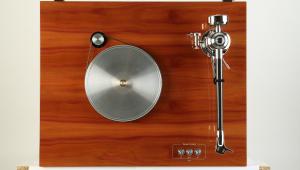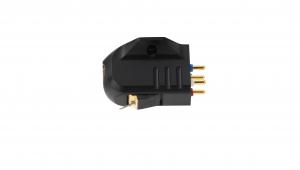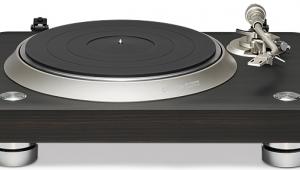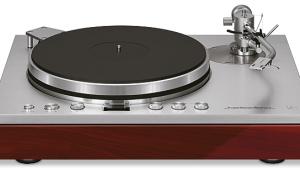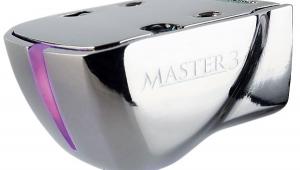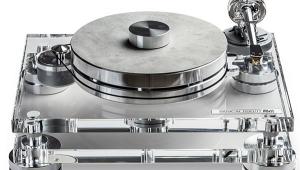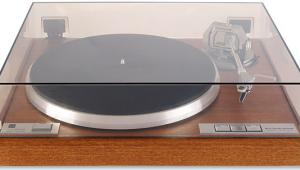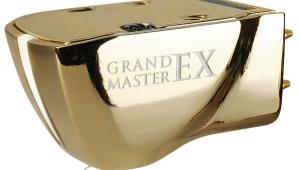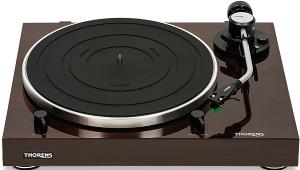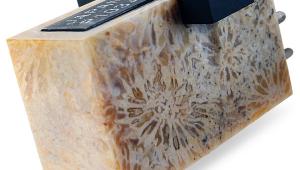Avid Acutus Reference Sp Turntable (£12,000)
You’ve got to take your hat off to Avid Hi-Fi. Its top-of-the-range Acutus deck, first introduced 12 years ago and enhanced with the launch of the Reference outboard power supply in 2006, is certainly one beast of a turntable. Resplendent in black and silver chrome that’s polished to a mirror finish, it makes for an imposing sight atop any audiophile’s equipment rack. Want to make the ultimate statement? The deck is also available to order finished in polished 24K gold plate, though for this you’ll have to add an extra 35% to the price. During the past year or so the company has been introducing ‘SP’ upgrades across its entire range of turntables. What we have here, then, is the latest incarnation of Avid’s flagship, the Acutus Reference SP. Like all of the firm’s decks with ‘SP’ nomenclature its external power supply (that provides electronic speed switching between 33 and 45rpm) is a new design dubbed the ‘DSP Vari-SPeed supply’ featuring on-board digital signal processing to control frequency generation. Also common to Avid’s ‘SP’ decks is a twin belt drive system that claims to better control platter dynamics and stability under load.
BUILT FOR SPEED
As the name implies, the power supply now allows fine speed adjustment. On this top-of-range Reference supply for the Acutus, for example, there are three buttons on the fascia. One starts and stops the platter, the other two are for selecting the speed. Pressing and holding both speed selection buttons simultaneously moves the unit into speed adjustment mode, where one button speeds up the platter in fine increments and the other slows it down. You’ll need a strobe disc to set it accurately, of course. Once the desired speed is reached, pressing both buttons together once more stores the speed setting in memory.
While certainly looking every bit a super-heavyweight, with its 45cm-tall 10kg platter and chunky suspension towers, the Acutus is actually a fairly compact design with a modest 410x360mm footprint (wd), so you’ll have no difficulty accommodating it on the top shelf of any standard-sized audio equipment rack. But don’t forget you’ll need a substantial shelf to house the Reference power supply that sets this deck apart from the ‘standard’ £8000 Acutus. The supply alone weights just over 20kg.
If you choose to install it yourself rather than have your dealer set it up for you, opening the substantial packing carton reveals a ‘kit of parts’ that is initially rather daunting. But the design is beautifully thought out, and thanks to the explicit assembly instructions the Acutus can be assembled in a matter of literally a few minutes. It’s the fitting of your chosen arm and accurately aligning your cartridge that takes the time...
Comprising a main chassis of cast aluminium with levelling feet that holds the deck’s three suspension towers, and a separate motor unit that is easily fixed in place with a rubber O-ring in a matter of seconds, the separate subchassis sports three downward-facing ‘legs’ that simply locate into each tower containing a suspension spring. Each of the Acutus’s three springs is the same, but adjustable so that the frequency of movement is the same independent of load. Spring adjustments are accessed through holes in the top of the towers using a supplied Allen wrench. Rubber O-rings fixed to the three towers work as lateral damping, and quickly return the platter to the vertical plane to provide a truly pistonic up/down movement of the subchassis and platter, with a resonant frequency of 2-2.5Hz.
BEARING FRUIT
The Acutus’ AC synchronous motor is a custom-designed hand-built unit that Avid says is around ten times more powerful than the norm at 140mNm (milliNewton metre), housed in its own pod and positioned just behind the front-left spring tower. Recent enhancements to all Avid decks include the use of a ‘dry’ bearing that requires no maintenance; in the Acutus a stainless steel inverted bearing shaft is tipped with a single-point self-lubricating tungsten carbide ball that sits in a sapphire cup. Care is required to avoid shock and potential damage to the bearing when installing or removing the platter.
The only fiddly aspect of the deck’s set-up concerns installing the two round-section drive belts, first to the sub platter section milled out on the underside of the platter while the platter is inverted, holding the belts in position with the aid of a small locating pin, and then turning the platter right-way-up, placing it carefully on the deck and looping the belts over the motor pulley. It takes a couple of attempts to acquire the knack.
You’ll need to get accustomed to the correct procedure for using the record clamp too, the clamp being integral to the design. Playing records without it is not an option as the brass top section of the bearing housing [pictured overleaf] sits slightly proud of the platter’s bonded polymer surface. Consequently an unclamped record ‘flaps around’ as it fails to mate properly with the platter. This is quite deliberate, as the purpose of the clamp is to secure the record directly to the Acutus’ main bearing.
Our review sample was fitted with an SME Series V tonearm, into which we installed Ortofon’s sublime ruby-cantilevered Cadenza Blue moving-coil cartridge. Auditioning was undertaken using my resident Sensor Prelude phono stage made by RCM Audio (imported by Select Audio) and Mark Levinson No.383 amplifier driving Townshend Audio
‘Sir Galahad’ loudspeakers.
SQUEAKY CLEAN
The Acutus Reference’s overall presentation appears tightly focused and controlled. Leading edges of notes, from the soft and delicate to the loudest, most explosive crescendos, were sharply delineated and squeaky clean.
Jan Garbarek’s ‘Molde Canticle, Part 3’ from his 1990 album I Took Up The Runes [ECM 1419] sounded bold and powerful while possessing a beguiling coherence and effortless, relaxed feel. The melodic lines delivered by bass maestro Eberhard Weber were uncommonly easy to follow, where on lesser record players the subtle touches and inflections in his playing become all too easily blurred by the over-prominent subsonic thumps of Manu Katche’s kick drum. And although Garbarek’s wailing soprano saxophone can often become jarring in digital ECM recordings such as this, the sound remained lucid and actually rather silky – even when Garbarek let rip during crescendos.
And this is not because the deck sounds smooth and mellow. Far from it, as it displays plenty of attack and zest. Sounding fast and authoritative partnered with the SME tonearm, there was joyus alacrity to Sly ’n’ Robbie’s rhythm section on Joe Cocker’s Sheffield Steel [Island ILPS 9700], while his gruff vocal delivery stood out from the production with uncommonly fine diction and projection. There was nothing bloated about the sound of this turntable combo, everything appearing tight, sharp and lucid, which allowed you to hear deep into the mix of complex multitrack recordings to pick out the subtlest of details.
When listening to ‘Couldn’t Bear To Be Special’ from Prefab Sprout’s Swoon album [Kitchenware, KWLP1] the low frequency ‘thunder’ effects had the kind of control one usually associates with CD replay, without an ounce of spare flesh artificially colouring the sound. The Acutus Reference makes vinyl sound not only clean but articulate too, Prefab Sprout’s Paddy McAloon appearing frail and exposed as the halo of reverberation around his voice was portrayed vividly within the stereo image. The low-level swirling of electronic keyboards in the recording, together with the percussion fills and ethereal backing vocals, were delineated clearly within a cavern of eerie blackness, sound images seemingly locked in tight focus between and beyond the boundaries of the loudspeakers.
NOTHING FORCED...
It’s funny how the cosmetic appearance of a turntable can sometimes lead one to second-guess how it might sound. The svelte, delicate look of Oracle’s drop-dead-gorgeous Delphi turntable, for example, gives an impression of refinement – and curiously it does rather sound like that – but you’d be wrong if you thought this grand and imposing Avid Acutus Reference SP might be all about blood ’n’ guts and thunder, with heroic bass to blow your socks off. Not so. Its bass performance is impressive sure enough, Tony Levin’s thumping bass ‘stick’ on King Crimson’s Beat album [EG Records, EGLP 51] demonstrating noble power and ‘slam’, but the Acutus’ main sonic character is best described as a ‘stately coolness’ – where nothing appears forced or over-lit.
The sound is ultra-clean, with fast, tight bass and lucid midband combined with equally fast treble and superb detail retrieval. Somehow it has the ability to sound explicit without a trace of harshness or over-etching, so the weeping electronic guitar of Crimson’s Robert Fripp was exposed without ever becoming brittle. As you’d imagine, female voices were beautifully served too. I found myself captivated by the richness and detail in lead singer Martha Johnson’s voice when listening to Martha And The Muffins’ 1981 LP This Is The Ice Age [Dindisc Records, DIN 10] despite Daniel Lanois’ typically dense production. The combo did seem to extract all the information it possibly could from the record’s 30-year-old grooves.
Given its fast, vivid sound and exemplary build quality, is there anything not to like about the Acutus Reference? Well, it goes without saying that you need to be able to afford the lofty price tag. Moreover, you should budget a further £350 for an acrylic dust cover. As with all ‘oil-rig’ type skeletal decks such as this, there’s no plinth and lid supplied to keep the dust at bay.
VERDICT
With its fabulous detail retrieval and focused sound, the Acutus Reference SP delivers a captivating performance. Moreover its elaborate suspension makes it immune to the vagaries of positioning – not something that can be said about most turntables. Beautifully made, compact, easy to set up and maintain, the only reason not to want it is the high-end cost. Aaah… the price of luxury.
Sound Quality: 86%
Originally published in the September 2010 issue






